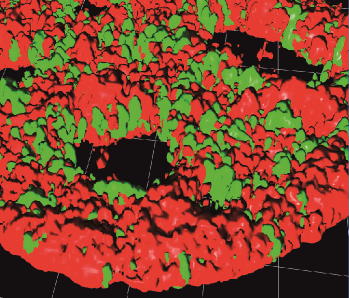Chromatin and Nuclear Architecture

In the last years innovative high-throughput-based genome conformational analysis combined with advanced imaging revealed that each chromosome is folded in a highly organized fashion and occupies specific territories in the nucleus, ensuring adequate regulation of gene expression and the maintenance of genome integrity. The group is devoted in understanding how the genome folding occur in the nuclear space finding the right orientation and nuclear position and how this conformation is then maintained or regulated in dynamic physiological processes in health and in disease.
We started studying epigenetic factors known to play a key role in genome folding and function, the Polycomb group (PcG) of proteins. We described for the first time a functional and evolutionary conserved crosstalk between the nuclear Lamin A/C and the PcG proteins; this being required for the maintenance of the PcG repressive functions.
In two recent works, we show how mutation of Lamin A can generate a dysfunctional Polycomb program leading to a defect in cell identity maintenance in laminopathies, human disorders caused by mutations in Lamin A/C gene. We are now committed in understanding the role of PcG/LaminA interplay in aging and cancer. In parallel we developed a new high-throughput sequencing technique to study different levels of chromatin solubility. This technology, applied in several primary tissues and cell types, will be instrumental to investigate the role of chromatin conformation in pathology insurgence and/or progression.
RESEARCH TOPICS
We have set up a novel technology, the Sequential Analysis of MacroMolecules accessibilitY (SAMMY-seq; patent N. EP3640330), which classifies DNA on the basis of its nuclear compartmentalization (Nat Comm 2020, in press). Using SAMMY-seq, we detected early stage alterations of chromatin structure in prostate and colon cancers.
The long-term goal of our research is the identification of relevant early-stage epigenetic and nuclear structure alterations that can be predictive of the cancer progression.
We are studying the muscle physiological and pathological senescence measuring firstly the muscle/fat distribution and metabolite analysis by Magnetic Resonance (MRI) and then the chromatin conformation. Bioinformatic analysis of muscle satellite stem cells revealed two age-related remodelling of chromatin: at the transition between juvenile (19 days) and adult stage (1-3 months) and at the transition between old (24 months) and geriatric age (28 months).
The long-term goal of this project is to find the functional link between genome conformation and fat accumulation in senescence muscles, to understand if physiological and pathological aging share some aberrant molecular mechanisms.
Using the SAMMYseq we found in resting lymphocytes an unconventional distribution of genomic chromatin domains, with repressed H3K9me3 marked domains being more accessible. In collaboration with bioinformaticians and physicists we are analysing data on activated lymphocytes to understand the biological function of this alternative chromatin conformation.
STAFF

Chiara Lanzuolo
Senior Researcher